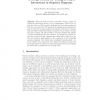Free Online Productivity Tools
i2Speak
i2Symbol
i2OCR
iTex2Img
iWeb2Print
iWeb2Shot
i2Type
iPdf2Split
iPdf2Merge
i2Bopomofo
i2Arabic
i2Style
i2Image
i2PDF
iLatex2Rtf
Sci2ools
FASE
2005
Springer
2005
Springer
Coverage Criteria for Testing of Object Interactions in Sequence Diagrams
This work defines several control-flow coverage criteria for testing the interactions among a set of collaborating objects. The criteria are based on UML sequence diagrams that are reverse-engineered from the code under test. The sequences of messages in the diagrams are used to define the coverage goals for the family of criteria, in a manner that generalizes traditional testing techniques such as branch coverage and path coverage. We also describe a run-time analysis that gathers coverage measurements for each criterion. To compare the criteria, we propose an approach that estimates the testing effort required to satisfy each criterion, using analysis of the complexity of the underlying sequence diagrams. The criteria were investigated experimentally on a set of realistic Java components. The results of this study compare different approaches for testing of object interactions and provide insights for testers and for builders of test coverage tools.
Control-flow Coverage Criteria | FASE 2005 | Sequence Diagrams | Software Engineering | UML Sequence Diagrams |
| Added | 27 Jun 2010 |
| Updated | 27 Jun 2010 |
| Type | Conference |
| Year | 2005 |
| Where | FASE |
| Authors | Atanas Rountev, Scott Kagan, Jason Sawin |
Comments (0)

